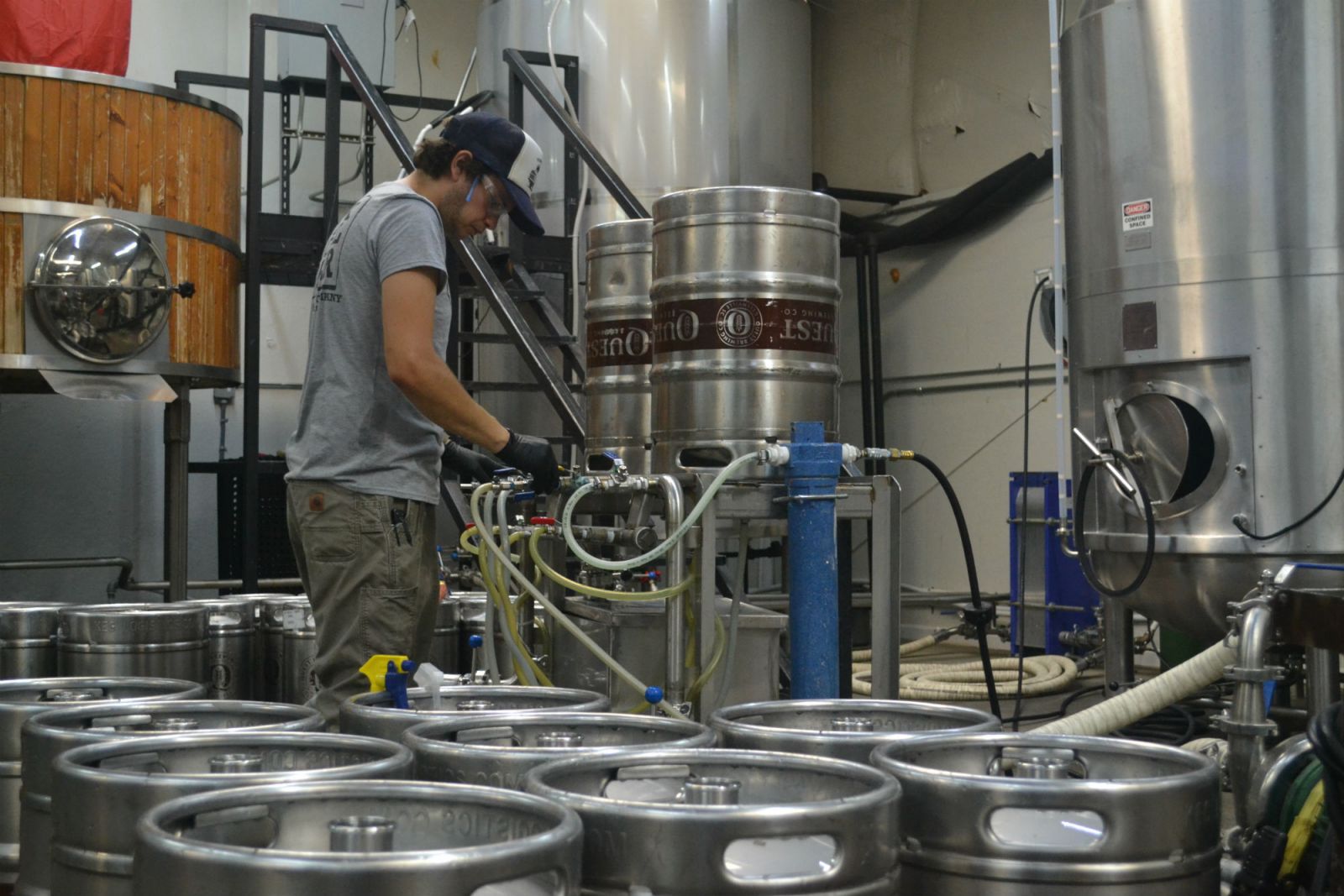Craft breweries continue to surge in South Carolina
Ross Norton //June 13, 2018//
Editor's Note: This story originally appreared in the June 11, 2018 issue of GSA Business Report.
In his 1984 book, The Complete Joy of Home Brewing, Charlie Papazian wrote about his paradise — the time in America before the Volstead Act prohibited alcohol. With the longing of a man who clearly wished to time travel, he described a country with “literally thousands” of breweries serving a wide variety of beer before prohibition took the number to zero.
When his book was published, the number had risen slowly to 97, according to the Brewers Association, a national organization that he played a central role in founding. The Brewers Association says there were 4,131 American breweries in 1873.
Today, for Papazian and his ilk, paradise has been found again. A decade after his book was written, there were 601 breweries. At the end of last year, there were more than 6,000.
 According to Brook Bristow, often called South Carolina’s beer lawyer, there is no sign that the growth of regional and craft breweries will be slowing anytime soon.
According to Brook Bristow, often called South Carolina’s beer lawyer, there is no sign that the growth of regional and craft breweries will be slowing anytime soon.
“I’m optimistic about the future,” he said. “It’s still coming and doesn’t seem to be slowing. There’s never been a better time to be a brewer in South Carolina than right now.”
It wasn’t without some work, though, said Bristow, who fell into being a beer lawyer when he volunteered to help some guys wade through the legal challenges to opening a brewery. Early on, state and local laws discouraged the industry; today the laws help it thrive. Getting here took some work and some time, and it started with changes in federal law, Bristow said.
President Jimmy Carter opened the industry for change in 1978 when he signed a law reopening the market to craft beer and home brew. Papazian and other home brew enthusiasts led a consumer movement of home brewers and beer consumers who developed a taste for more complex beer.
While craft beer was taking off in other parts of the country, not much was happening in South Carolina. Hunter-Gatherer Brewery & Alehouse opened in Columbia in 1995, RJ Rockers in Spartanburg opened in 1997 and Thomas Creek in 1998. Charleston had Palmetto Brewing. In the rest of the country, enclaves of beer culture were leading to good things for communities, including real estate development and investment. Places where traditional values had sometimes offered resistance to anything that promoted alcohol were also places that traditionally valued pro-business politics. Eventually, pro-business began to win out over anti-alcohol principles, Bristow said.
In 2007 the so-called Pop the Cap initiative in South Carolina led to a change in law that increased maximum alcohol by weight from 5% to 14%. A 2010 law allowed brewery visitors to buy a flight of beer — four sample glasses that totaled 16 ounces. In 2013 a change gave patrons the right to have four full beers.
The Stone Law in 2014 may have seemed like a failure at first, Bristow said, because it was part of an effort to lure Stone Brewery from California to South Carolina, but they ended up in Virginia.
“The Stone Law was (enacted) to build a brewery that ended up in Richmond, but all along we knew it was a way to help all breweries in the state. For us, it was about jobs for everybody,” said Bristow, who is also executive director of the S.C. Brewers Guild. The Stone law allows brewpubs to operate without the 48-ounce limit, just like any other restaurant.
South Carolina may have been late to the microbrewery and brewpub game, but when the movement took off, it soared.
From 2011 to 2017, the number of breweries more than quintupled from 11 to 61 and more are on the way, said Bristow, who often is hired to walk new breweries through the process. Hunter-Gatherer owner Kevin Varner opened a second Columbia location in January.
“A lot of communities realize what a brewery can do for them. They’ve seen breweries revitalize certain neighborhoods,” Bristow said. “A lot of the real estate developers want a neighborhood brewery because they see what it can do. It’s worth noting that since the 2013 law change the economic impact has gone up $400 million in four or five years and doubled or tripled the number of jobs. It’s certainly been a rocket ship to the moon in the last 12 years.”
The Brewers Association puts the total economic impact of the craft beer industry in South Carolina at $650 million in 2017, which is 28th among states in terms of dollars, but 49th in impact per capita.
The breweries produced 108,211 barrels of beer in 2017, 34th among states in volume but 41st in per-capita rankings with 0.9 gallons of beer brewed per resident aged 21 or older.
By comparison, Vermont brewers produced 18.9 gallons of beer per drinking-age resident, tops in the country, for a $309 million impact. The 764 craft breweries of California have a $7.3 billion impact on the state’s economy, both nation-leading numbers, according to the Brewers Association. California brewers produce 3.2 million gallons of craft beer annually. Only Pennsylvania produces more craft beer: 3.7 million gallons annually.
Brewers Association economist Bart Watson said the craft beer industry continues to grow nationwide, up 5% in 2017, but not everything is rosy. In a report to members on the first quarter of 2018, he said that although total production is up, a lot of it is attributed to new businesses and some breweries actually produced fewer barrels of beer last year than in 2016.
“As the number of breweries has exploded, slowing growth plus more breweries means that per brewer growth numbers have declined significantly,” he wrote. “It’s clear that although the category is still growing, breweries individually are growing less than they expected a few years ago.”
Growth per brewery was less than 200 barrels last year. In 2014, it was almost 900 barrels.
“Given that there still appear to be thousands of breweries in planning, this pattern is likely here to stay for several years,” Watson said. “It will be difficult for all breweries to succeed in this environment, but professional brewing is fundamentally a business, and in any business there is the risk of failure.”
Bristow, who often volunteers his time in his clients’ breweries said it’s an industry that requires business savvy, a stout back and passion for beer.
“Like any business or endeavor, if it’s something you’re not passionate about, don’t do it,” he said. “It’s sexy but it’s still a manufacturing job and it’s hard work. You better know what you’re doing and you better be ready to work.”
Henry Depew, one of the owners of RJ Rockers Brewing Co. in Spartanburg, acknowledges the hard work, but he said the product and the atmosphere and culture it creates make it worth the effort.
“The brewing industry is taking off. I believe it is a product of most of us wanting to be a local company involved with community that gives people a place to meet and talk with family, friends and coworkers,” he said. “We are all small businesses that work very hard. I believe people see that and are thankful for the effort, the beer and the space to be able to have in-person communications with others.”
The owner and brewer of Rail Line Brewing in Simpsonville also cited that sense of community that happens over a pint.
“Over the past years while Facebook and Twitter gave us this interconnectivity, people miss it outside of work, and tap rooms form community and connectivity and a place for people to go and be a part of a group and part of something they enjoy,” William Haynes said. “Craft brew is not particularly expensive, so you can do a lot of exploration at a great price.”


















